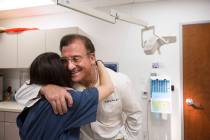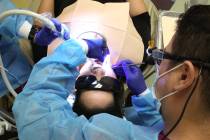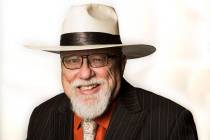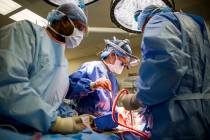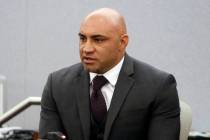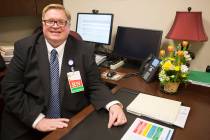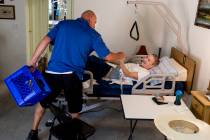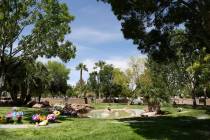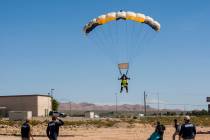Las Vegas paramedic rides shotgun as lives start, fade away
As the car left the road and hit the ditch, the driver was ejected and the car rolled over her.
Paramedic John Osborn answered the 911 call phoned in by a witness to the accident.
When Osborn arrived, the woman was walking around, talking to herself, apparently in shock but otherwise in good shape.
There was a perfect imprint of her body in a farmer's freshly plowed pasture.
It was then, in that soft Colorado field, where he sank almost to his knees with each step, that the fledgling first responder realized that while death is a certainty of life, the timing of the end doesn't always square with seemingly inescapable reality.
Nearly 25 years have passed since Osborn saw death kept at bay by cradling soil. During that time, most of it spent as a paramedic in Southern Nevada, he's done his best through the care he provides -- often in an ambulance speeding to an emergency room and an awaiting trauma team -- to play the role of the good earth.
"You can never give up on anybody," the 52-year-old Osborn said recently as he stood outside his ambulance at MedicWest headquarters in North Las Vegas. "You never know who's going to make it."
A heart that's stopped doesn't mean death to Osborn.
"We've restarted a lot of them (with CPR and defibrillators)," he said.
Osborn, who stands 6-foot-3 and weighs 300 pounds, is about to work the 4 p.m. to 4 a.m. shift with Hillary Hetzel. They will respond to emergency calls from North Las Vegas and eastern Clark County. They may end up with a child with a crochet hook stuck in his mouth or a motorcycle rider who fell while doing tricks on the freeway.
Dr. Dale Carrison, head of the University Medical Center Emergency Department, calls paramedics "my eyes and ears in the field. John makes good patient assessments. That is so important because we can be prepared for the patient."
Osborn has been trained to administer a variety of emergency medications, including those used to treat heart attacks and respiratory problems. He can manage spinal injuries, fractures and burns, assist in childbirths, create airways.
What he always focuses on are the people he helps.
There was the young man who lived after being shot nine times, whose blood sprayed through the ambulance.
There was the father accidentally shot by his son who didn't expect anyone on that night to come into his home. And there was the grieving mother and father -- their child was found at the bottom of a swimming pool -- holding the feet of their little one as CPR was administered unsuccessfully.
And parents trying to understand why their teens shot themselves.
"So many times with these accidents and situations you realize that people's lives are going to be changed forever," Osborn said. "You know the guilt is going to eat them alive."
He remembers having to tell a 12-year-old girl who was trying to wake up her mother that her mom was dead. And he remembers a teenager telling him she shot his patient in the leg because he went out with another girl.
There are people who take advantage of ambulance services, who know that someone who dials 911 for an ambulance must be picked up. He's transported a homeless woman to the hospital three times in the past few weeks.
"Who wants to spend the holidays sleeping in a box?" he said. "I can understand how she feels, but we're going to have to do something about this in this town."
There are also people for whom an ambulance is called but who refuse to go because of the cost.
"I just hate to see that," he said. "It's usually old people who don't feel they can pay the bill when it's sent, so they refuse to go. I can't make them. I'm sure some people have died because of that."
Once Osborn was called to the parking lot of Cimarron-Memorial High School. The pregnant parent of a student there started having contractions.
"We delivered the baby in the front seat," he said. "I've actually delivered quite a few."
Osborn is close to 30 years older than many paramedics he's trained, including his current partner. But he has no intention of retiring.
"I can't believe I get paid to do this job," he said. "It's great helping people for a living. If I have off two or three days, I really want to get back to work."
Paul Harasim is the medical reporter for the Las Vegas Review-Journal. His column appears Mondays. Harasim can be reached at pharasim@reviewjournal.com or 702-387-2908.








